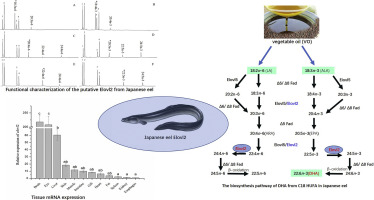当前位置:
X-MOL 学术
›
Comp. Biochem. Physiol. B Biochem. Mol. Biol.
›
论文详情
Our official English website, www.x-mol.net, welcomes your feedback! (Note: you will need to create a separate account there.)
The catadromous teleost Anguilla japonica has a complete enzymatic repertoire for the biosynthesis of docosahexaenoic acid from α-linolenic acid: Cloning and functional characterization of an Elovl2 elongase.
Comparative Biochemistry and Physiology B: Biochemistry & Molecular Biology ( IF 2.2 ) Pub Date : 2019-10-31 , DOI: 10.1016/j.cbpb.2019.110373 Wenju Xu 1 , Shuqi Wang 2 , Cuihong You 2 , Yueling Zhang 2 , Óscar Monroig 3 , Douglas R Tocher 4 , Yuanyou Li 5
Comparative Biochemistry and Physiology B: Biochemistry & Molecular Biology ( IF 2.2 ) Pub Date : 2019-10-31 , DOI: 10.1016/j.cbpb.2019.110373 Wenju Xu 1 , Shuqi Wang 2 , Cuihong You 2 , Yueling Zhang 2 , Óscar Monroig 3 , Douglas R Tocher 4 , Yuanyou Li 5
Affiliation

|
The Japanese eel Anguilla japonica is a catadromous fish species with considerable farming scale. Previous studies showed that dietary α-linolenic acid (18:3n-3) and linoleic acid (18:2n-6) satisfied essential fatty acid requirements in eel, which suggested that Japanese eel should have a complete pathway for the biosynthesis of long-chain polyunsaturated fatty acids (LC-PUFA). However, existing knowledge was insufficient to explain the molecular basis of LC-PUFA biosynthetic capacity in eel. In order to further characterize this pathway in eel, a full-length cDNA of a putative fatty acyl elongase was isolated, with the ORF encoding a protein with 294 amino acids. The putative elongase displayed high homology to Elovl2 of other teleosts. Functional characterization by heterologous expression in yeast showed the protein product of the cDNA had high activity towards C20 and C22 PUFA substrates and low activity towards C18 PUFA substrates, characteristic of Elovl2 elongases. Tissue distribution of the elovl2 mRNA showed highest expression in brain and eyes, which was different from freshwater and anadromous species. This may reflect an important role for this enzyme in the in situ endogenous biosynthesis of docosahexaenoic acid (DHA) in neural tissues in eel. This is the first report of an Elovl2 in a catadromous teleost and demonstrates that Japanese eel has a complete enzyme repertoire required for the endogenous biosynthesis of DHA via the Sprecher pathway. These data have increased our knowledge of the diversity of LC-PUFA biosynthesis in vertebrates, and provided further insight into the regulatory mechanisms of LC-PUFA biosynthesis in teleost fish.
中文翻译:

过硬的硬骨鱼类鳗鱼具有从α-亚麻酸生物合成二十二碳六烯酸的完整酶库:Elovl2延伸酶的克隆和功能表征。
日本鳗鳗(Anguilla japonica)是一种具有相当规模的养殖规模的cat鱼。先前的研究表明,饮食中的α-亚麻酸(18:3n-3)和亚油酸(18:2n-6)满足了鳗鱼的必需脂肪酸要求,这表明日本鳗鱼应该为长寿虾的生物合成提供一条完整的途径。链多不饱和脂肪酸(LC-PUFA)。但是,现有知识不足以解释鳗鱼中LC-PUFA生物合成能力的分子基础。为了进一步表征鳗鱼中的该途径,分离了假定的脂肪酰基延长酶的全长cDNA,其中ORF编码具有294个氨基酸的蛋白质。推定的延伸酶与其他硬骨鱼的Elovl2具有高度同源性。通过酵母中异源表达的功能表征表明,cDNA的蛋白质产物对C20和C22 PUFA底物具有高活性,对C18 PUFA底物具有低活性,这是Elovl2延伸酶的特征。elovl2 mRNA的组织分布在脑和眼中表达最高,这与淡水和缺水物种不同。这可能反映了该酶在鳗鱼神经组织中二十二碳六烯酸(DHA)的原位内源性生物合成中的重要作用。这是Elovl2在硬骨鱼类中的首次报道,证明日本鳗鱼具有通过Sprecher途径内源性合成DHA所需的完整酶库。这些数据增加了我们对脊椎动物LC-PUFA生物合成多样性的认识,
更新日期:2019-10-31
中文翻译:

过硬的硬骨鱼类鳗鱼具有从α-亚麻酸生物合成二十二碳六烯酸的完整酶库:Elovl2延伸酶的克隆和功能表征。
日本鳗鳗(Anguilla japonica)是一种具有相当规模的养殖规模的cat鱼。先前的研究表明,饮食中的α-亚麻酸(18:3n-3)和亚油酸(18:2n-6)满足了鳗鱼的必需脂肪酸要求,这表明日本鳗鱼应该为长寿虾的生物合成提供一条完整的途径。链多不饱和脂肪酸(LC-PUFA)。但是,现有知识不足以解释鳗鱼中LC-PUFA生物合成能力的分子基础。为了进一步表征鳗鱼中的该途径,分离了假定的脂肪酰基延长酶的全长cDNA,其中ORF编码具有294个氨基酸的蛋白质。推定的延伸酶与其他硬骨鱼的Elovl2具有高度同源性。通过酵母中异源表达的功能表征表明,cDNA的蛋白质产物对C20和C22 PUFA底物具有高活性,对C18 PUFA底物具有低活性,这是Elovl2延伸酶的特征。elovl2 mRNA的组织分布在脑和眼中表达最高,这与淡水和缺水物种不同。这可能反映了该酶在鳗鱼神经组织中二十二碳六烯酸(DHA)的原位内源性生物合成中的重要作用。这是Elovl2在硬骨鱼类中的首次报道,证明日本鳗鱼具有通过Sprecher途径内源性合成DHA所需的完整酶库。这些数据增加了我们对脊椎动物LC-PUFA生物合成多样性的认识,



























 京公网安备 11010802027423号
京公网安备 11010802027423号